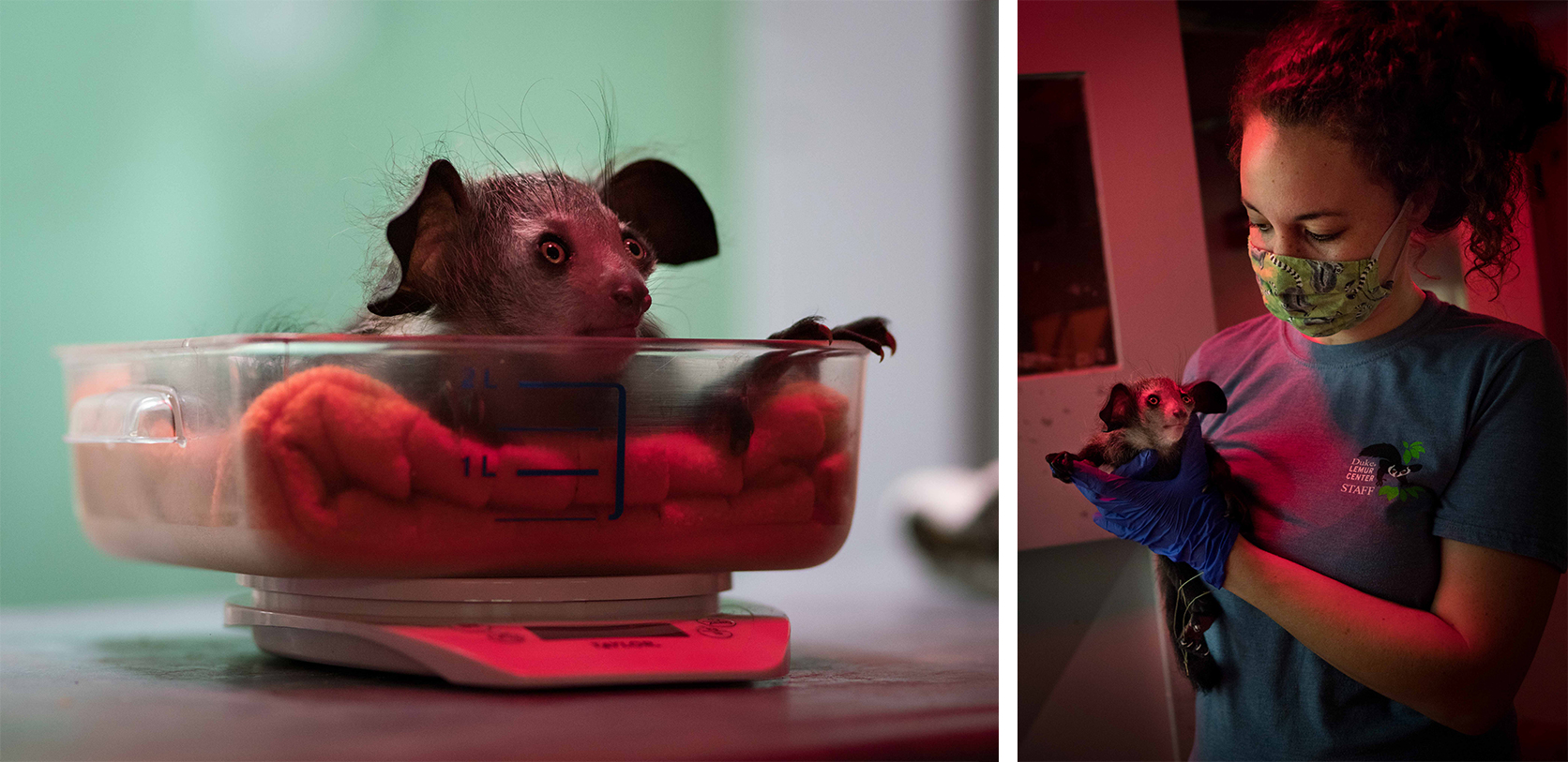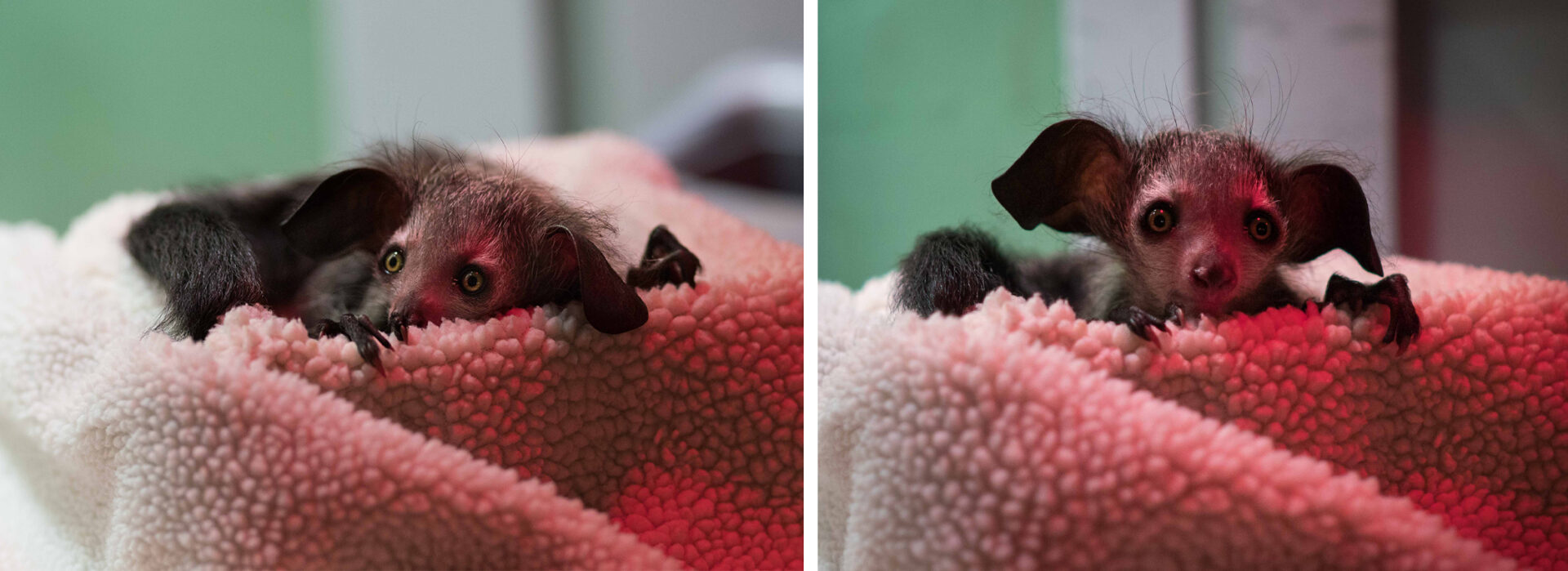
Winifred on June 27 (left) and August 11 (right). Aye-ayes at the Duke Lemur Center are named after spooky characters. Winifred is named after Winifred Sanderson, the eldest witch and main antagonist in Disney’s Hocus Pocus.
The Duke Lemur Center has welcomed another newborn — a rare baby aye-aye.
Christened Winifred after Bette Midler’s character Winifred Sanderson in Hocus Pocus, the infant was born to first-time mom Fady on June 24, 2020. She is the second offspring of her father, Grendel, who sired Melisandre in 2019.
Fady, Winifred’s mother, came to the Duke Lemur Center from the San Diego Zoo to join our conservation breeding program, as organized through the Association of Zoos and Aquariums’ (AZA) Species Survival Plan. Aye-ayes are endangered in Madagascar, and there are fewer than 30 individuals within human care in the United States. Of those, 10 live at the Duke Lemur Center, where they help maintain a genetic safety net for aye-ayes in the wild.
Through her father, Nirina, Fady introduces a brand-new genetic line into the DLC’s aye-aye population. Prior to her arrival, all of the aye-ayes at the Lemur Center were descendants of the DLC’s eight founder aye-ayes. Genetic diversity is crucial, as aye-ayes in human care help form a genetic safety net for their species. The more genetically diverse a population is, the more resilient and healthy it tends to be.
“Baby lemurs bring a smile to your face and make your heart beat a little faster,” says Greg Dye, Executive Director of the DLC. “But they’re also a reminder of what’s at stake. Not only does Winifred grab your heart, she underscores the importance of the Lemur Center’s work protecting aye-ayes and other lemurs from extinction. Our mission is to never know a world without them.”
Jenna Browning, Fady and Winnie’s primary caretaker, reports that although Fady is a first-time mom, she’s doing a wonderful job caring for her infant. There is always some trial and error when you’re new at motherhood—Fady did try (unsuccessfully) to pick Winifred up with her hands, for example, instead of using her mouth to carry her like most aye-aye moms do—but she’s been a careful and attentive mother, leaving her baby’s side only to eat or to gather materials to add to her nest.
“Fady is an outstanding nest builder,” says Jenna. As aye-ayes learn nest-building from their mothers, Jenna hopes that Winifred will inherit her mother’s architectural gifts.
Winifred, who seems to have inherited her mother’s curiosity, began peeping out of the nest at five weeks old. Just two weeks later, she was ready to explore the wider world. This video (below), taken on August 12, records Winnie’s very first time venturing all the way out of the nest. As you can see, she’s a strong little one—even at just seven weeks old!
Learn more
Ask an Expert: If you’d like to learn even more about this amazing species, or how we care for moms and infants here at the DLC, then we suggest checking out our Ask an Expert virtual program! The general Q&A session with a member of our education team would be perfect for all of your aye-aye-, lemur baby-, and Winifred-related questions!
Symbolically Adopt an Aye-aye: Did you know you can symbolically adopt Agatha, an aye-aye born at the DLC in 2017, through the DLC’s Adopt a Lemur Program? Your adoption goes toward the $8,400 per year cost it takes to care for each lemur at the DLC, as well as aiding our conservation efforts in Madagascar. You’ll also receive quarterly updates and photos, making this a fun, educational gift that keeps giving all year long! Please visit our Adopt a Lemur homepage to learn more.
Explore: To learn more about the DLC’s aye-ayes, visit our Meet the Lemurs webpage. Our virtual tour also has an entire episode dedicated exclusively to the weird and wonderful aye-aye!

Winifred with caretaker Jenna during a routine weighing and wellness check on August 11. Like Fady, this is Jenna’s first time caring for a baby aye-aye, too. “The experience has been so great, so fascinating. Aye-ayes are very rare, so we don’t get this opportunity very often. I’m grateful I get to experience this as a keeper!”

Press inquiries
Published August 19, 2020. For more information, please contact:
Sara Clark
Director of Communications, Duke Lemur Center
sara.clark@duke.edu

Winifred, approximately one week old. Photo courtesy of Jenna Browning.

